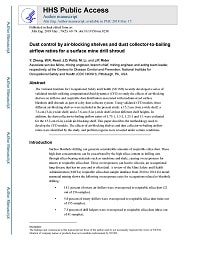Mining Publication: Dust Control by Air-blocking Shelves and Dust Collector-to-Bailing Airflow Ratios for a Surface Mine Drill Shroud
Original creation date: May 2018
Authors: Y Zheng, W Reed, J Potts, M Li, J Rider
The National Institute for Occupational Safety and Health (NIOSH) recently developed a series of validated models utilizing computational fluid dynamics (CFD) to study the effects of air-blocking shelves on airflows and respirable dust distribution associated with medium-sized surface blasthole drill shrouds as part of a dry dust collector system. Using validated CFD models, three different air-blocking shelves were included in the present study: a 15.2-cm (6-in.)-wide shelf; a 7.6-cm (3-in.)-wide shelf; and a 7.6-cm (3-in.)-wide shelf at four different shelf heights. In addition, the dust-collector-to-bailing airflow ratios of 1.75:1, 1.5:1, 1.25:1 and 1:1 were evaluated for the 15.2-cm (6-in.)-wide air-blocking shelf. This paper describes the methodology used to develop the CFD models. The effects of air-blocking shelves and dust collector-to-bailing airflow ratios were identified by the study, and problem regions were revealed under certain conditions.

- Control of Respirable Dust
- Drill Monitor With Strata Strength Classification in Near-Real Time
- Improved Drill Shroud Capture of Respirable Dust Utilizing Air Nozzles Underneath the Drill Deck
- Improving Silica Dust Control Through Targeted Research
- Improving the Performance of Fan-Powered Dust Collectors in Stone-Cutting Applications
- NIOSH Hazard Controls 27 - New Shroud Design Controls Silica Dust from Surface Mine and Construction Blast Hole Drills
- Silica Dust Sources in Underground Limestone Mines
- Silica Dust Sources in Underground Metal/Nonmetal Mines - Two Case Studies
- Summary of NIOSH Research Completed on Dust Control Methods for the Surface and Underground Drilling
- Technology News 447 - Dust Collector Discharge Shroud Reduces Dust Exposure to Drill Operators at Surface Coal Mines